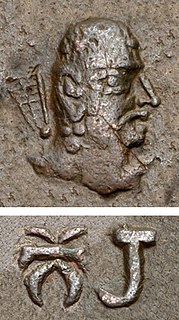 W
WThe Hephthalites, sometimes called the White Huns, were a people who lived in Central Asia during the 5th to 8th centuries. They existed as an empire and were militarily important between 450 to 560. They were based in Bactria and expanded east to the Tarim Basin, west to Sogdia and south through Afghanistan, but they never went beyond the Hindu-Kush, which was occupied by the Alchon Huns. They were a tribal confederation and included both nomadic and settled urban communities. They were part of the four major states known collectively as Xyon (Xionites) or Huna, being preceded by the Kidarites, and the Alkhon, and succeeded by the Nezak Huns and the First Turkic Khaganate. All of these Hunnic peoples have often been linked to the Huns who invaded Eastern Europe during the same period, and/or have been referred to as "Huns", but there is no consensus among scholars about such a connection.
 W
WFaghanish was a Hephthalite prince, who was the ruler of Chaghaniyan in the mid 6th-century. Originally a subordinate of the Hephthalite king, he became a vassal of the Sasanian Empire in c. 560 after the Hephthalite Empire was broken into several minor kingdoms when they suffered a crushing defeat to a combined Sasanian-Turkic army at Gol-Zarriun.
 W
WHunas or Huna was the name given by the ancient Indians to a group of Central Asian tribes who, via the Khyber Pass, entered the Indian Subcontinent at the end of the 5th or early 6th century. Huna Kingdom occupied areas as far as Eran and Kausambi, greatly weakening the Gupta Empire. The Hunas were ultimately defeated by the Indian Gupta Empire and the Indian king Yasodharman.
 W
WJavukha was the third known king of the Alchon Huns, in the 5th century CE. He is described as such in the Talagan copper scroll inscription, where he is also said to be Maharaja, and the "son of Sadavikha". In the scroll he also appears to be rather contemporary with Toramana.
 W
WKhingila I was the founding king of the Hunnic Alkhan dynasty. He was a contemporary of Khushnavaz.
 W
WMehama, ruled c.461-493, was a king of Alchon Huns dynasty. He is little known, but the Talagan copper scroll mentions him as an active ruler making a donation to a Buddhist stupa in 492/93. At that time, it is considered that the Alchon Huns were firmly in charge of the Buddhist region around Taxila, but had not yet started to conquer the Indian mainland.
 W
WMihirakula, also Mihiragula or Mahiragula, was one of the most important rulers of the Alchon Huns, who led a conquest and gained temporary control of Gandhara, Kashmir, northern and central India. Mihirakula was a son of Toramana, both of Huna heritage, and ruled the Indian part of the Hephthalite Empire. Mihirakula ruled his empire from 502 to 530, from his capital of Sagala.
 W
WNēzak Shāh was a Nezak king of the late 5th-century, and possibly the founder of a dynasty bearing the same name. On his coins, his name appears in Pahlavi script as "nycky MLK". He was ruling in the area of Kabul, modern Afghanistan. His coins are rather numerous and characteristic of the Kabul region, and have also been found in Buddhist stupas and monasteries in Taxila.
 W
WNarendraditya Khinkhila, also called Naranda or Narenda or Deva Shahi Khingila from his coin legends, was one of the last rulers of the Alchon Huns in the area of Gandhara and Kashmir in northwestern India, following their retreat from northern India, during the 6th century CE. According to Kalhana's 12th century text Rajatarangini, where is full name Narendraditya Khinkhila is used, he was the son of a king named Gokarna, a follower of Shiva. Narendraditya is also known to have consecrated a shrine to Shiva, names Bhutesvara.
 W
WRana Datasatya or possibly Ranaditya Satya on his coins, was a ruler in the area of Sindh, modern-day Pakistan, in the 5-6th centuries CE, probably circa 480 CE.
 W
WSri Pravarasena, also sometimes Pravarasena II based on the regnal lists of the Rajatarangini, was a 6th-century Huna king of the Alchon Huns in the area of Gandhara and Kashmir in northwestern India. His reign probably lasted about 60 years from circa 530 CE.
 W
WToramana also called Toramana Shahi Jauvla was a king of the Alchon Huns who ruled in northern India in the late 5th and the early 6th century CE. Toramana consolidated the Hephthalite power in Punjab, and conquered northern and central India including Eran in Madhya Pradesh. Toramana used the title "Great King of Kings", equivalent to "Emperor", in his inscriptions, such as the Eran boar inscription.
 W
WZunbil, also written as Zhunbil, was a royal dynasty south of the Hindu Kush in present southern Afghanistan region. They ruled from the early 7th century until the Saffarid conquest in 870 AD. The Zunbil dynasty was founded by Rutbil, the elder brother of the Turk Shahi Tegin Shah, who ruled over a Western Turk-Hephthalite kingdom from his capital in Kabul. The Zunbils are described as having Turkish troops in their service by Arabic sources like Tarikh al-Tabari and Tarikh-i Sistan.